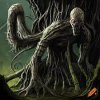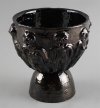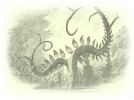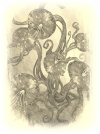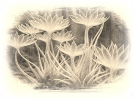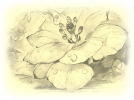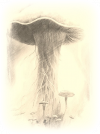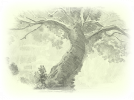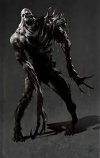ChamomileHasWords
New Member
Observations on Spindlesap
Sinnvane
The spindlesap of the eponymous wood has been a mystery for as long as these lands have known civilization. These woods have been a thorn in the side of Balgamor for long enough, and I have recently made an expedition within their lightless depths to uncover their secrets, and perhaps discover some use for them, or failing that, at least some means of destroying the damnable things so that the cloying strands may be removed far from the boundaries of farmsteads and meadows now so plagued by the marauding spiders who make themselves so at home in the damnable woods.
To begin with, I have dissected one of the spiders felled in the expedition to retrieve its spinnerets and compared the fluid extruded from it to that of nearby webs, then cut down one of the spindlesap trees to investigate the veins of spindlesap running through its rings. Comparison between the two makes it clear that though both of these substances are sticky and pale, they have very few similarities otherwise. The spider webs are spun in strands behind the spider, as is often observed in the more common sort as fits in the palm of the hand and may be found in walls or gardens of even the most well-kept of buildings, and as such these webs tend to be long and slender things, of lighter hue and glistening in the light, often spun into great webs between trees in which I have discovered the emaciated corpses of many birds, rabbits, and in some larger cases even deer, wolves, and a great grizzly bear. Though I say the webs are slender, their thickness varies depending upon the spider who spins them, and the larger creatures are trapped in webs spun by proportionately larger spiders.
Contrariwise, spindlesap is of a darker grey color and extrudes itself from the spindlesap trees, hanging off of them like moss and gathered into clumps like foam at the crest of a wave, only grey and snaring. While the danger of being stuck in a spindlesap web and devoured by the spiders of the forest is well known, and the occasional ancient corpse of some unfortunate peasant with more courage than wisdom attests to the spinlesap trees' ability to ensnare outsiders, local animals are almost never found caught in the foam of the branches. When they are, I have found they are always at the outskirts of the forest, which makes me suspect that when animals are caught in spindlesap, it is animals who live outside and are driven into the forest, perhaps fleeing a predator.
Not all spiders spin their thread into a traditional net-shaped web. I have found tunnels whose interiors are covered in the lighter webs of the spiders, and though the dense-packed netting causes the webs to blend into one another like soup mixing in a pot, the edges of the webs, where they meet the surrounding soil, show clear signs of being formed of individual strands. The subterranean spiders are simply much more thorough than the arboreal ones, it seems, I suspect because the subterranean spiders seek to create lairs which only spiders can enter, while the arboreal ones are laying traps that they hope their prey will not see. Certainly the thin strands can be difficult to spot without the aid of bright lights, in which the webs glisten, and the thickly packed trees of Spindlesap Forest, with all gaps in branches filled in by the dense clusters of spindlesap upon them, allows no sunlight to penetrate. I cannot recommend venturing into Spindlesap Forest under any circumstances, but at minimum one should certainly not even consider journeying there without a reliable light source, a powerful lantern at least and preferably some magical form of illumination.
Further study of the spindlesap and how the spiders interact with it will, I believe, require some of the spiders captured and some of the trees dug up and transported to where a secure enclosure can be constructed. While the Dame Commander of Balgamor has offered her resources to assist, I fear the industrial runoff of the region may prove detrimental to the health of the trees, the spiders, or both. In many ways this is reassuring, but it would be a great waste of the risk and effort of retrieving the trees if they withered and died before a proper study of them could be completed. As such, I hope to find a place for such an enclosure somewhere on the academy grounds.
Sinnvane
The spindlesap of the eponymous wood has been a mystery for as long as these lands have known civilization. These woods have been a thorn in the side of Balgamor for long enough, and I have recently made an expedition within their lightless depths to uncover their secrets, and perhaps discover some use for them, or failing that, at least some means of destroying the damnable things so that the cloying strands may be removed far from the boundaries of farmsteads and meadows now so plagued by the marauding spiders who make themselves so at home in the damnable woods.
To begin with, I have dissected one of the spiders felled in the expedition to retrieve its spinnerets and compared the fluid extruded from it to that of nearby webs, then cut down one of the spindlesap trees to investigate the veins of spindlesap running through its rings. Comparison between the two makes it clear that though both of these substances are sticky and pale, they have very few similarities otherwise. The spider webs are spun in strands behind the spider, as is often observed in the more common sort as fits in the palm of the hand and may be found in walls or gardens of even the most well-kept of buildings, and as such these webs tend to be long and slender things, of lighter hue and glistening in the light, often spun into great webs between trees in which I have discovered the emaciated corpses of many birds, rabbits, and in some larger cases even deer, wolves, and a great grizzly bear. Though I say the webs are slender, their thickness varies depending upon the spider who spins them, and the larger creatures are trapped in webs spun by proportionately larger spiders.
Contrariwise, spindlesap is of a darker grey color and extrudes itself from the spindlesap trees, hanging off of them like moss and gathered into clumps like foam at the crest of a wave, only grey and snaring. While the danger of being stuck in a spindlesap web and devoured by the spiders of the forest is well known, and the occasional ancient corpse of some unfortunate peasant with more courage than wisdom attests to the spinlesap trees' ability to ensnare outsiders, local animals are almost never found caught in the foam of the branches. When they are, I have found they are always at the outskirts of the forest, which makes me suspect that when animals are caught in spindlesap, it is animals who live outside and are driven into the forest, perhaps fleeing a predator.
Not all spiders spin their thread into a traditional net-shaped web. I have found tunnels whose interiors are covered in the lighter webs of the spiders, and though the dense-packed netting causes the webs to blend into one another like soup mixing in a pot, the edges of the webs, where they meet the surrounding soil, show clear signs of being formed of individual strands. The subterranean spiders are simply much more thorough than the arboreal ones, it seems, I suspect because the subterranean spiders seek to create lairs which only spiders can enter, while the arboreal ones are laying traps that they hope their prey will not see. Certainly the thin strands can be difficult to spot without the aid of bright lights, in which the webs glisten, and the thickly packed trees of Spindlesap Forest, with all gaps in branches filled in by the dense clusters of spindlesap upon them, allows no sunlight to penetrate. I cannot recommend venturing into Spindlesap Forest under any circumstances, but at minimum one should certainly not even consider journeying there without a reliable light source, a powerful lantern at least and preferably some magical form of illumination.
Further study of the spindlesap and how the spiders interact with it will, I believe, require some of the spiders captured and some of the trees dug up and transported to where a secure enclosure can be constructed. While the Dame Commander of Balgamor has offered her resources to assist, I fear the industrial runoff of the region may prove detrimental to the health of the trees, the spiders, or both. In many ways this is reassuring, but it would be a great waste of the risk and effort of retrieving the trees if they withered and died before a proper study of them could be completed. As such, I hope to find a place for such an enclosure somewhere on the academy grounds.
New hex: 04,07: Spindlesap Forest. A forest full of giant spiders of several different varieties. In addition to the webs of the spiders, the trees themselves extrude spindlesap, a web-like substance that coats most of their trunks and branches and blots out the sun.
Last edited:


